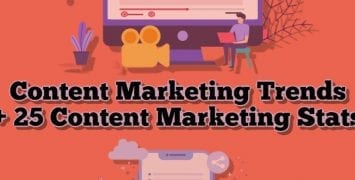How often do you publish a new blog post?
There’s no one correct answer. Generally, however, I recommend adding a new post to your blog section at least twice a week.
These can be short posts of about 500 words. You can then supplement these with a few pieces of long-form content each month.
This can quickly add up to a lot of content. And it’s not like you can just write blog posts about your day or your thoughts on current events. Each post must be related to your industry and tailored to the interests of your audience.
This quickly leads to a situation where you’re likely struggling to find topics to write about.
Trust me, I’ve been there.
Over the years, I’ve learned a few great ways to develop topics for blog posts. These tips, topics and strategies apply to basically any type of industry. Let’s take a look:
How-To Guides: Always a Popular Choice
When you want to learn how to do something, what’s your first step? If you’re like most people, you probably start with a Google search.
A How-To Guide is a step-by-step set of instructions on how to complete a specific task.
How-To Guides are popular in practically every industry one can think of. Take a look at the many subjects available on WikiHow, just to name one source of guides.
You want your How-To guides to be direct, simple and informative. Get right to the point. Remember: Your readers want information first. You can promote your brand slightly near the end of the guide, but don’t do so up-front.
Interviews: Learn from the Experts
Connect with experts in your field and interview them about interesting topics related to your industry. As part of your SEO efforts, you should already be networking with others in your industry. If not, check out my guide on how to Connect with Other Bloggers Using These Top Outreach Tools.
There are many different types of interviews you can conduct. Ask about the person’s role, if they have an interesting job related to your industry. If the interviewee has something interesting – or even controversial – about any current industry trend, ask them to elaborate.
Personal Stories: Connect with Your Audience
Every once in a while – about twice a month – write a blog piece about the people in your organization. Take the reader behind the scenes of your company. Give readers a sense of the people behind the brand.
People are drawn to your brand, but they’ll want to connect to you on a personal level. When potential customers get to know you, they’ll develop trust. When trust is formed, people feel far more comfortable making an online purchase.
Beginner Guides: We All Gotta Start Somewhere
A How-To Guide, as mentioned above, is a step-by-step set of instructions on how to complete a specific task. A Beginner Guide is something different. With a Beginner Guide, you’re presenting a complete overview of a subject for beginners.
For example:
- “Maintaining Your Home Swimming Pool for Beginners”
- “Your Complete Guide to Twitter Ads”
A Beginner Guide is written for someone who has basically no experience in the subject being discussed. You’ll want to be very clear and helpful. Many Beginner Guides include an extensive FAQ and Glossary.
Advanced Guides: Taking it to the Next Level
Of course, not everyone is a beginner. You can also create Advanced Guides which cover more complex material. This helps your brand establish authority in your industry.
If you have more basic guides related to the subject, include links. I put the links to the basic guides right at the top of my Advanced Guides. This way anyone who wants a beginner guide will easily be able to go to one of mine.
New blog posts are an important part of maintaining a connection with your customer base and a high position in the SERP.




